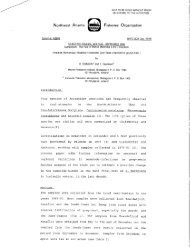Early Stages of Fishes in the Western North Atlantic Ocean Volume ...
Early Stages of Fishes in the Western North Atlantic Ocean Volume ...
Early Stages of Fishes in the Western North Atlantic Ocean Volume ...
You also want an ePaper? Increase the reach of your titles
YUMPU automatically turns print PDFs into web optimized ePapers that Google loves.
Peduncle A narrow part (or stalk) by which some larger part<br />
<strong>of</strong> <strong>the</strong> whole body is attached or jo<strong>in</strong>ed to a distal structure<br />
Pelvic f<strong>in</strong> One <strong>of</strong> a pair <strong>of</strong> rayed f<strong>in</strong>s, usually located on <strong>the</strong><br />
ventral edge <strong>of</strong> <strong>the</strong> body <strong>in</strong> <strong>the</strong> abdom<strong>in</strong>al or "chest" region;<br />
sometimes located anteriorly, under <strong>the</strong> head; <strong>in</strong> some taxa,<br />
this f<strong>in</strong> is reduced to one or a few filamentous rays or is totally<br />
absent<br />
Pelagic Of, relat<strong>in</strong>g to, or liv<strong>in</strong>g <strong>in</strong> <strong>the</strong> open sea<br />
Pelagic-juvenile A specialized stage between larvae and settled<br />
juveniles; generally occupy same habitats as larvae, have<br />
complete meristic characters, but also may have specialized<br />
characters such as elongate f<strong>in</strong> rays, sp<strong>in</strong>es or unique pigment<br />
patterns; many <strong>of</strong> <strong>the</strong>se have been described as new genera<br />
(e.g. "Svetovidovia" (Moridae); "Krohnius" (Macrouridae);<br />
"Querrimana" (Mugilidae); etc.<br />
Periproct Tissue (<strong>of</strong>ten black) surround<strong>in</strong>g <strong>the</strong> anus (e.g. <strong>in</strong><br />
<strong>the</strong> Macrouridae)<br />
Peritoneal pigment Internal pigment on <strong>the</strong> peritoneum or<br />
dorsum <strong>of</strong> <strong>the</strong> abdom<strong>in</strong>al cavity (see explanatory figure)<br />
Peritoneum Smooth, transparent membrane that l<strong>in</strong>es <strong>the</strong><br />
cavity <strong>of</strong> <strong>the</strong> abdomen<br />
Perivitell<strong>in</strong>e space Fluid-filled space between <strong>the</strong> fertilization<br />
membrane and <strong>the</strong> chorion <strong>of</strong> a fish egg<br />
Photophores Lum<strong>in</strong>ous organs on various mar<strong>in</strong>e (mostly<br />
deep-sea) fish larvae<br />
Pigmentation Deposition <strong>of</strong> pigment <strong>in</strong> various body tissues<br />
Planktonic Passively float<strong>in</strong>g, drift<strong>in</strong>g, or weakly swimm<strong>in</strong>g<br />
with prevail<strong>in</strong>g currents<br />
Polyhal<strong>in</strong>e Refers to estuar<strong>in</strong>e areas where <strong>the</strong> sal<strong>in</strong>ity ranges<br />
from 18.0 to 30.0 parts per thousand<br />
Polyphyletic a group <strong>of</strong> organisms is polyphyletic if <strong>the</strong> trait<br />
its members have <strong>in</strong> common evolved separately <strong>in</strong> different<br />
places <strong>in</strong> <strong>the</strong>ir ancestry. Equivalently, a polyphyletic taxon<br />
does not conta<strong>in</strong> <strong>the</strong> most recent common ancestor <strong>of</strong> all its<br />
members (see "Monophyletic" and "Paraphyletic")<br />
Post Posterior<br />
Posterior Situated toward <strong>the</strong> rear portion <strong>of</strong> <strong>the</strong> body or a<br />
body structure; opposite to anterior (see explanatory figure)<br />
Postflexion stage A stage <strong>in</strong> <strong>the</strong> development <strong>of</strong> larvae after<br />
<strong>the</strong> completion <strong>of</strong> flexion (which see) and after resorption <strong>of</strong><br />
<strong>the</strong> urostyle tip<br />
Postorbital Situated beh<strong>in</strong>d (posterior to) <strong>the</strong> orbit<br />
Posttemporal sp<strong>in</strong>e A sharp, externally visible, process<br />
emerg<strong>in</strong>g from <strong>the</strong> posttemporal bone <strong>of</strong> <strong>the</strong> skull (see explanatory<br />
figure)<br />
PrC Pr<strong>in</strong>cipal caudal f<strong>in</strong> rays (abbreviation); refers to those<br />
rays (branched and unbranched) that articulate with any <strong>of</strong><br />
several ural bones (e.g. hypurals and parhypural). Also see<br />
<strong>Early</strong> <strong>Stages</strong> <strong>of</strong> <strong>Fishes</strong> <strong>in</strong> <strong>the</strong> <strong>Western</strong> <strong>North</strong> <strong>Atlantic</strong> <strong>Ocean</strong> xli<br />
"Pr<strong>in</strong>cipal rays"<br />
Preanal Situated <strong>in</strong> front <strong>of</strong> orig<strong>in</strong> <strong>of</strong> anal f<strong>in</strong> or anal f<strong>in</strong>fold<br />
(see explanatory figure); "Preanal length" is measured from<br />
tip <strong>of</strong> snout to orig<strong>in</strong> <strong>of</strong> anal f<strong>in</strong><br />
Preanus Situated <strong>in</strong> front <strong>of</strong> <strong>the</strong> anus; "Preanus length" is<br />
measured from tip <strong>of</strong> snout to anus<br />
Predorsal bones Synonymous with "supraneural"; for discussion<br />
<strong>of</strong> homologies among and between predorsal bones,<br />
supraneurals, pterygiophores and neural sp<strong>in</strong>es, see Mabee<br />
(1988)<br />
Preflexion stage A stage <strong>in</strong> <strong>the</strong> development <strong>of</strong> larvae before<br />
<strong>the</strong> beg<strong>in</strong>n<strong>in</strong>g <strong>of</strong> <strong>the</strong> process <strong>of</strong> flexion<br />
Premaxillae Paired bones <strong>of</strong> upper jaw, usually bear<strong>in</strong>g<br />
teeth and associated with paired maxillae<br />
Preopercle Upper anterior bone <strong>of</strong> <strong>the</strong> operculum (see explanatory<br />
figure)<br />
Preopercular sp<strong>in</strong>es Sp<strong>in</strong>es along <strong>the</strong> lateral ridge or posterior<br />
edge <strong>of</strong> <strong>the</strong> preopercle bone; when numbered, <strong>the</strong>y are<br />
counted from <strong>the</strong> lowermost (or most ventral) to <strong>the</strong> uppermost<br />
(usually situated at <strong>the</strong> level <strong>of</strong>, and beh<strong>in</strong>d, <strong>the</strong> eye)<br />
Pr<strong>in</strong>cipal rays In <strong>the</strong> caudal f<strong>in</strong>, a group <strong>of</strong> f<strong>in</strong> rays articulat<strong>in</strong>g<br />
with hypural bones and support<strong>in</strong>g most <strong>of</strong> <strong>the</strong> surface <strong>of</strong><br />
<strong>the</strong> caudal f<strong>in</strong>; <strong>the</strong>se typically reach <strong>the</strong> posterior marg<strong>in</strong> <strong>of</strong><br />
<strong>the</strong> f<strong>in</strong>; an <strong>of</strong>ten present, typical number <strong>in</strong> perciform fishes<br />
is 17 (9+8), with <strong>the</strong> central 15 branched, plus 1 unbranched<br />
ray dorsally and 1 unbranched ray ventrally (see "Procurrent<br />
ray" and explanatory figures)<br />
Procurrent ray F<strong>in</strong> rays <strong>in</strong> <strong>the</strong> caudal f<strong>in</strong> not articulat<strong>in</strong>g<br />
with hypural bones, usually shorter than pr<strong>in</strong>cipal rays and<br />
generally not reach<strong>in</strong>g <strong>the</strong> posterior marg<strong>in</strong> <strong>of</strong> caudal f<strong>in</strong>. Occur<br />
<strong>in</strong> 2 series, 1 dorsal, 1 ventral, both extend<strong>in</strong>g anteriorly<br />
from pr<strong>in</strong>cipal rays. Also referred to as secondary caudal f<strong>in</strong><br />
rays (see explanatory figures)<br />
Procurrent spur A po<strong>in</strong>ted structure on <strong>the</strong> base <strong>of</strong> <strong>the</strong> posteriormost<br />
ventral procurrent ray found <strong>in</strong> some fishes <strong>in</strong> certa<strong>in</strong><br />
acanthopterygian orders. May or may not be accompanied<br />
by a fore-shortened preced<strong>in</strong>g ray (which see). Johnson<br />
(1975) presents presence or absence <strong>of</strong> <strong>the</strong>se 2 characters <strong>in</strong><br />
a survey <strong>of</strong> fishes <strong>in</strong> 4 major orders (Beryciformes, Stephanoberyciformes,<br />
Perciformes and Scorpaeniformes) (see explanatory<br />
figures)<br />
Proximal Near po<strong>in</strong>t <strong>of</strong> attachment or orig<strong>in</strong>; opposite <strong>of</strong><br />
"Distal"<br />
Pseudocaudal A caudal end structure <strong>in</strong> fishes <strong>of</strong> <strong>the</strong> family<br />
Molidae where a true caudal f<strong>in</strong> and support<strong>in</strong>g structures are<br />
lack<strong>in</strong>g. The notochord tip atrophies dur<strong>in</strong>g larval development<br />
<strong>in</strong> molids, and a series <strong>of</strong> f<strong>in</strong> rays and pterygiophores<br />
extend from <strong>the</strong> dorsal and anal f<strong>in</strong>s which <strong>the</strong>n meet each<br />
o<strong>the</strong>r <strong>in</strong> <strong>the</strong> gap created by lack <strong>of</strong> caudal f<strong>in</strong> rays. Also<br />
termed "clavus". See detailed description <strong>of</strong> this structure <strong>in</strong>






